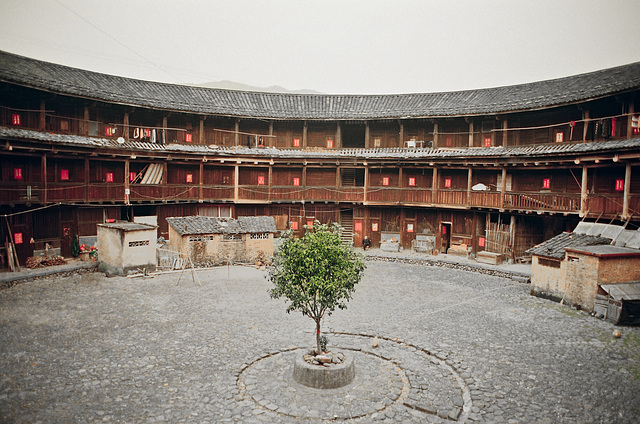Round Tulou (private house)
Entering tulou
Tulou gate
Dried salad?
Before the Rain (Field trip)
Night tulou
Rice wine
Manual water-powered wheel
Buddhist temple
Chongwu Harbour
Chongwu Harbour
Chongwu Harbour
Chongwu Harbour
Tide
Tourism with Chinese characteristics
Let's photo (Hui'an maidens)
Dragons on my rooftop
Meditation
Chongwu city walls
Laozi under Mount Qingyuan
Laozi - Old teacher
Detail of Laozi's face
Mount Qingyuan
Family tree, here u r
Private tulou
Family tree BW
Old trees of Gulangyu
Gulangyu boke'
Old buildings at 鼓浪屿
Before sunset, in Gulang islet
Xiamen seafront
Xiamen seafront
Blurry snapshot of a modern koolie
Student statue
Old tree and its beauty
University life
Moped is useful
Principal Head of China (House)
Highspeedtrain
Er Guo Tou 。。。 二锅头
Hurly-burly III.
Hurly-burly II.
Hurly-burly I.
Warmly welcome
*New* Chinese
Location
See also...
Keywords
Authorizations, license
-
Visible by: Everyone -
All rights reserved
-
480 visits
Family tree


Unlike other housing types around the world with architecture reflecting social hierarchy, Fujian Tulou exhibits its unique characteristic as a model of community housing for equals. All rooms were built the same size with the same grade of material, same exterior decoration, same style of windows and doors, and there was no "penthouse" for "higher echelons"; a small family owned a vertical set from ground floor to "penthouse" floor, while a larger family would own two or three vertical sets.
Tulous were usually occupied by one large family clan of several generations; some larger tulou had more than one family clan. Besides the building itself, many facilities such as water wells, ceremonial hall, bathrooms, wash rooms, and weaponry were shared property. Even the surrounding land and farmland, fruit trees etc. were shared. The residents of tulou farmed communally. This continued into the 1960s even during the people's commune period; at that time a tulou was often occupied by one commune production team. Each small family has its own private property, and every family branch enjoys its privacy behind closed doors.
In the old days, the allotment of housing was based on family male branch; each son was counted as one branch. Public duties such as organization of festivals, cleaning of public areas, opening and closing of the main gate, etc., was also assigned to a family branch on a rotational basis.
All branches of a family clan shared a single roof, symbolizing unity and protection under a clan; all the family houses face the central ancestral hall, symbolizing worship of ancestry and solidarity of the clan. When a clan grew, the housing expanded radially by adding another outer concentric ring, or by building another tulou close by, in a cluster. Thus, a clan stayed together.
Nowadays newer housing with modern facilities is popping up in rural China. Many residents have bought more modern houses and moved out, or live in a larger town or city for better jobs. However they keep their ancestral tulou apartment homes under padlock, only returning home during festival for family reunion.
Tulous were usually occupied by one large family clan of several generations; some larger tulou had more than one family clan. Besides the building itself, many facilities such as water wells, ceremonial hall, bathrooms, wash rooms, and weaponry were shared property. Even the surrounding land and farmland, fruit trees etc. were shared. The residents of tulou farmed communally. This continued into the 1960s even during the people's commune period; at that time a tulou was often occupied by one commune production team. Each small family has its own private property, and every family branch enjoys its privacy behind closed doors.
In the old days, the allotment of housing was based on family male branch; each son was counted as one branch. Public duties such as organization of festivals, cleaning of public areas, opening and closing of the main gate, etc., was also assigned to a family branch on a rotational basis.
All branches of a family clan shared a single roof, symbolizing unity and protection under a clan; all the family houses face the central ancestral hall, symbolizing worship of ancestry and solidarity of the clan. When a clan grew, the housing expanded radially by adding another outer concentric ring, or by building another tulou close by, in a cluster. Thus, a clan stayed together.
Nowadays newer housing with modern facilities is popping up in rural China. Many residents have bought more modern houses and moved out, or live in a larger town or city for better jobs. However they keep their ancestral tulou apartment homes under padlock, only returning home during festival for family reunion.
ivanhoe, have particularly liked this photo
- Keyboard shortcuts:
Jump to top
RSS feed- Latest comments - Subscribe to the comment feeds of this photo
- ipernity © 2007-2024
- Help & Contact
|
Club news
|
About ipernity
|
History |
ipernity Club & Prices |
Guide of good conduct
Donate | Group guidelines | Privacy policy | Terms of use | Statutes | In memoria -
Facebook
Twitter

Sign-in to write a comment.